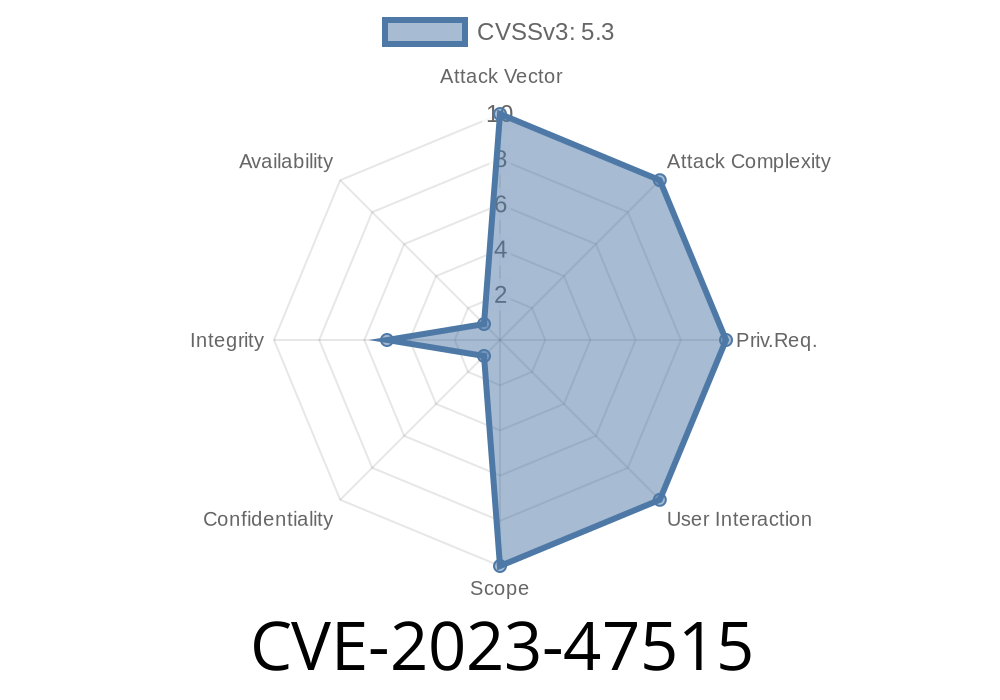A critical security vulnerability has been discovered in Seers, a popular access control system. This vulnerability, classified as CVE-2023-47515, enables an attacker to exploit the "Missing Authorization" issue present in Seers versions up to and including 8.1.1. In this post, we'll cover the details of this exploit, the affected Seers versions, possible attack scenarios, and some recommended mitigation steps.
Vulnerability Details
The identified vulnerability lies in the improper configuration of access control security levels in Seers, which ultimately allows unauthorized users to gain access to restricted resources by bypassing or manipulating the access control mechanisms in place. Specifically, this vulnerability can be exploited to perform actions without the necessary permissions, such as:
Vulnerable Versions
The CVE-2023-47515 vulnerability manifests in Seers installations from unspecified earlier versions up to and including Seers 8.1.1.
Here is an example of how the vulnerability may be exploited with Python-based code
import requests
url = "https://example.com/seers/api/resource/";
headers = {"Authorization": "Bearer attacker_token"}
# If the "Missing Authorization" issue is present,
# this request will succeed even if "attacker_token" doesn't have the necessary permissions
response = requests.get(url, headers=headers)
if response.status_code == 200:
print("Successfully accessed the protected resource:", response.json())
else:
print("Failed to access the protected resource")
This basic example demonstrates that it is possible to circumvent the access control mechanism with ease, potentially causing significant harm to your organization or system.
Original References
- National Vulnerability Database (NVD) Entry Link
- Seers Security Advisory Link
Exploit Details
As mentioned earlier, this vulnerability revolves around the incorrect configuration of security levels in Seers. This allows an attacker to take advantage of the lack of adequate authorization checks and carry out unauthorized actions on the platform.
Potential exploit scenarios include
1. Unauthorized Data Exposure: Attackers could gain access to sensitive data such as customer information, financial records, or other proprietary data.
2. Data Manipulation: Bad actors may be able to alter critical data, leading to inaccurate information or even system failure.
3. Privilege Escalation: Exploiting this vulnerability may enable attackers to execute functions that are meant only for high-level users, potentially compromising the entire system.
Mitigation Recommendations
To effectively minimize the associated risks, organizations using Seers should take the following precautionary steps:
1. Upgrade Seers to the latest version: If you are using a version of Seers that is vulnerable to CVE-2023-47515, it is recommended to upgrade to the latest and most secure release.
2. Review Access Control Configuration: Ensure that your access control security levels are correctly configured, and that all users have only the necessary permissions to perform their tasks.
3. Implement Regular Security Audits: Proactively check and verify the security of your Seers implementation and ensure that no security loopholes or misconfigurations are present.
Conclusion
The CVE-2023-47515 vulnerability, affecting several versions of the Seers access control system, poses a serious threat to organizations by allowing unauthorized users to exploit the "Missing Authorization" issue. It is imperative to take immediate action and implement the recommended mitigation steps to minimize the risk and secure your organization's assets and data.
Timeline
Published on: 01/02/2025 12:15:15 UTC
